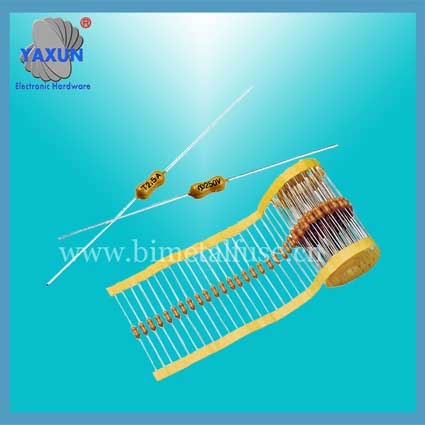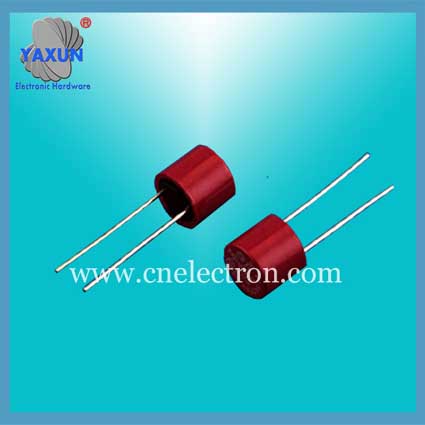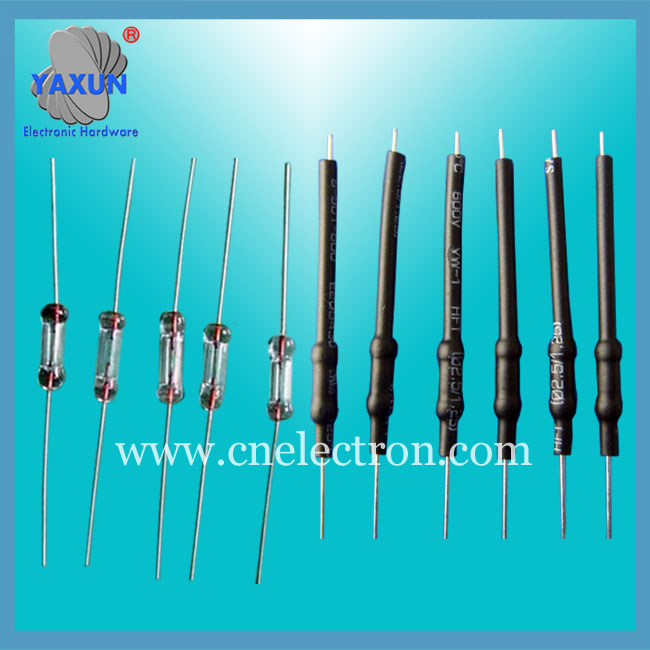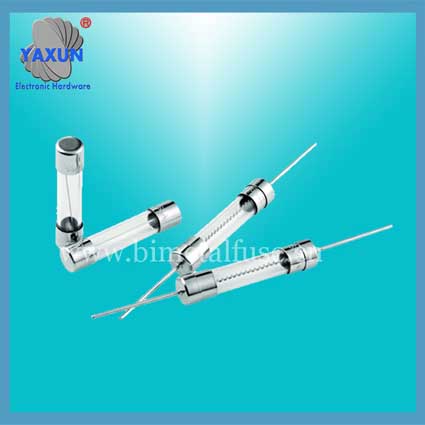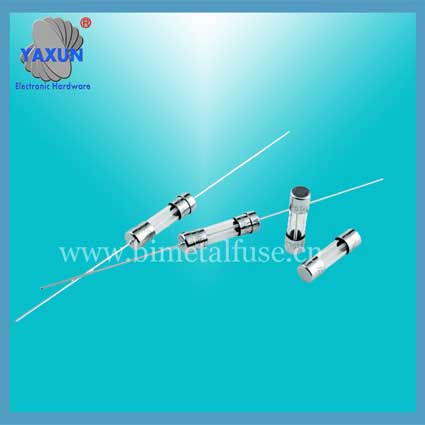3.6x10mm US Regulatory Glass _ Ceramic Tube Slow Blow Fuse
- PRODUCT DETAIL
Fuse breaking capacity
When a current between the conventional non-fusing current and the rated breaking capacity (current) specified by the relevant standard is applied to the fuse, the fuse should be able to operate quickly. And it will not endanger the surrounding environment. The expected fault current of the circuit in which the fuse is placed must be less than the rated breaking capacity current specified by the standard. Otherwise, when the fault occurs, the fuse will blow continuously, ignite, burn the fuse, melt together with the contacts, and the fuse mark will not be recognized. Of course, the breaking capacity of inferior fuses does not meet the requirements of the standard, and the above-mentioned hazards will also occur when used.
Fuse classification
According to the protection form, it can be divided into: overcurrent protection and overheat protection. The fuse used for overcurrent protection is the fuse usually called (also called current limiting fuse). Fuses used for overheating protection are commonly referred to as "temperature fuses". Thermal fuses are divided into low melting alloy shapes, temperature-sensitive trigger shapes, memory alloy shapes, etc. (Thermal fuses are used to protect heating appliances or appliances that are prone to heat from overheating. For example: hair dryer, electric iron, rice cooker, electric stove, transformer, electric motor, etc .; it responds to the rise in temperature of electrical appliances and does not care about the working current of the circuit. Its working principle is different from "current-limiting fuse").
According to the scope of use, it can be divided into: power fuses, machine tool fuses, electrical instrument fuses (electronic fuses), automotive fuses.
According to volume, it can be divided into: large, medium, small and micro.
According to the rated voltage, it can be divided into: high voltage fuse, low voltage fuse and safety voltage fuse.
According to breaking capacity, it can be divided into: high and low breaking capacity fuses.
Intentions to develop, to use technology to benefit society
According to shape, it can be divided into: Flat-head tubular fuse (also can be divided into internal welding fuse and external welding fuse), Tip of the tubular fuse, fuse guillotine, screw type fuses, blade fuses, fuse plates, wraps fuse, SMD fuses.
According to the melting speed, it can be divided into: Very slow fuse (usually represented by TT), slow fuse (usually represented by T).
Medium speed fuse (usually M), fast fuse (usually F), very fast fuse (usually FF).
According to the standard, it can be divided into: European fuse, American fuse, Japanese fuse.
According to type, it can be divided into: Current fuses (SMD fuses, miniature fuses, blade fuses, tubular fuses), Thermal fuse (RH [block type], RP [resistance type], RY [metal case]), Resettable fuse (plug-in, laminated, patch).
According to size, it can be divided into: 0603, 0805, 1206, 1210, 1812, 2016, 2920; Non-stick type Φ2.4 × 7, Φ3 × 7, Φ3.6 × 10, Φ4.5 × 15, Φ5.0 × 20, Φ5.16 × 20, Φ6 × 25, Φ6 × 30, Φ6 × 32, Φ8.5 × 8, Φ8.5 × 8 × 4, Φ10 × 38, Φ14 × 51.
Functional Characteristics
Approvals(○ Pending● Approvals)
When a current between the conventional non-fusing current and the rated breaking capacity (current) specified by the relevant standard is applied to the fuse, the fuse should be able to operate quickly. And it will not endanger the surrounding environment. The expected fault current of the circuit in which the fuse is placed must be less than the rated breaking capacity current specified by the standard. Otherwise, when the fault occurs, the fuse will blow continuously, ignite, burn the fuse, melt together with the contacts, and the fuse mark will not be recognized. Of course, the breaking capacity of inferior fuses does not meet the requirements of the standard, and the above-mentioned hazards will also occur when used.
Fuse classification
According to the protection form, it can be divided into: overcurrent protection and overheat protection. The fuse used for overcurrent protection is the fuse usually called (also called current limiting fuse). Fuses used for overheating protection are commonly referred to as "temperature fuses". Thermal fuses are divided into low melting alloy shapes, temperature-sensitive trigger shapes, memory alloy shapes, etc. (Thermal fuses are used to protect heating appliances or appliances that are prone to heat from overheating. For example: hair dryer, electric iron, rice cooker, electric stove, transformer, electric motor, etc .; it responds to the rise in temperature of electrical appliances and does not care about the working current of the circuit. Its working principle is different from "current-limiting fuse").
According to the scope of use, it can be divided into: power fuses, machine tool fuses, electrical instrument fuses (electronic fuses), automotive fuses.
According to volume, it can be divided into: large, medium, small and micro.
According to the rated voltage, it can be divided into: high voltage fuse, low voltage fuse and safety voltage fuse.
According to breaking capacity, it can be divided into: high and low breaking capacity fuses.
Intentions to develop, to use technology to benefit society
According to shape, it can be divided into: Flat-head tubular fuse (also can be divided into internal welding fuse and external welding fuse), Tip of the tubular fuse, fuse guillotine, screw type fuses, blade fuses, fuse plates, wraps fuse, SMD fuses.
According to the melting speed, it can be divided into: Very slow fuse (usually represented by TT), slow fuse (usually represented by T).
Medium speed fuse (usually M), fast fuse (usually F), very fast fuse (usually FF).
According to the standard, it can be divided into: European fuse, American fuse, Japanese fuse.
According to type, it can be divided into: Current fuses (SMD fuses, miniature fuses, blade fuses, tubular fuses), Thermal fuse (RH [block type], RP [resistance type], RY [metal case]), Resettable fuse (plug-in, laminated, patch).
According to size, it can be divided into: 0603, 0805, 1206, 1210, 1812, 2016, 2920; Non-stick type Φ2.4 × 7, Φ3 × 7, Φ3.6 × 10, Φ4.5 × 15, Φ5.0 × 20, Φ5.16 × 20, Φ6 × 25, Φ6 × 30, Φ6 × 32, Φ8.5 × 8, Φ8.5 × 8 × 4, Φ10 × 38, Φ14 × 51.
| Breaking Capacity | Material | Operating Temperature | Soldering conditions |
|
VDE:35A or 10ln whichever is greater(250mA-6.3A) UL:50 amperes at 125V/250V/300V AC (200mA-6.3A) |
Fuse body –glass tube End cap --nickel plated brass Pigtail--tin plated copper on nickel plated brass cap |
-40℃~+125℃ |
Wave solder:260℃,≤5S Hand solder: 360℃,≤1S |
Functional Characteristics
| Testing current | Blow Time | |
| Min | Max | |
| 150% | 1 hour | - |
| 210% | 1 s | 120s |
| 275% | 400ms | 10s |
| 400% | 150ms | 3s |
| 1000% | 20ms | 150ms |
Approvals(○ Pending● Approvals)
|
Current Rating |
Voltage Rating |
Norminal Melting I2T(A2sec) |
Approvals | ||||
| VDE | CQC | UL | PSE | KC | |||
| 200mA | 125V/250V | 0.21 | ● | ||||
| 250mA | 125V/250V | 0.27 | ● | ||||
| 300mA | 125V/250V | 0.29 | ● | ||||
| 315mA | 125V/250V | 0.30 | ● | ||||
| 350mA | 125V/250V | 0.32 | ● | ||||
| 400mA | 125V/250V | 0.48 | ● | ||||
| 500mA | 125V/250V | 0.45 | ● | ● | ● | ● | |
| 600mA | 125V/250V | 0.48 | ● | ||||
| 630mA | 125V/250V | 0.50 | ● | ||||
| 750mA | 125V/250V | 0.51 | ● | ||||
| 800mA | 125V/250V | 1.6 | ● | ||||
| 1A | 125V/250V | 4.2 | ● | ● | ● | ● | ● |
| 1.25A | 125V/250V | 4.5 | ● | ● | ● | ● | ● |
| 1.5A | 125V/250V | 4.9 | ● | ● | |||
| 1.6A | 125V/250V | 7.2 | ● | ● | ● | ● | ● |
| 2A | 125V/250V | 12 | ● | ● | ● | ● | ● |
| 2.5A | 125V/250V | 13 | ● | ● | ● | ● | ● |
| 3A | 125V/250V | 13 | ● | ● | |||
| 3.15A | 125V/250V | 28 | ● | ● | ● | ● | ● |
| 3.5A | 125V/250V | 30 | ● | ● | |||
| 4A | 125V/250V | 50 | ● | ● | ● | ● | ● |
| 5A | 125V/250V | 80 | ● | ● | ● | ● | ● |
| 6A | 125V/250V | 82 | ● | ||||
| 6.3A | 125V/250V | 127 | ● | ● | ● | ○ | ● |
| 7A | 125V/250V | 108 | ○ | ||||
| 8A | 125V/250V | 125 | ○ | ○ | ○ | ○ | ○ |
| 10A | 125V/250V | 180 | ○ | ○ | ○ | ○ | ○ |

